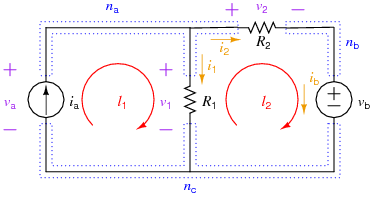Symbolic/Examples/Circuits
Contents
Brute Force 1
The following example shows the "brute force" method of setting up and solving for all the element currents and voltages for a simple resistive circuit and then using those solutions to solve for auxiliary information (in this case, some powers). The circuit involved is:
Equations
Element Equations
Mainly, these are Ohm's Law equations for the resistors, so:
KCL Equations
The number of independent KCL equations s one less than the number of nodes, so in this case, 2. Note: all three nodal KCL equations are written below, but node \(n_c\)'s is not used in the Maple worksheet.
KVL Equations
The number of independent KVL equations is equal to the number of meshes for a 2-D circuit, or to the number of elements, minus the number of nodes, plus one for circuits in general. In this case, that is 2 independent KVL (two meshes, or 3 elements - 3 nodes + 1 = 2). For the brute force method, just use the mesh equations:
Auxiliary Equations
For this example, the auxiliary equations will be used to determine the power delivered by each source and the power absorbed by each resistor:
Note that all elements except for \(i_a\) are labeled passively.
Code
Maple
The Maple worksheet for this example is available in the Maple Cloud at this Maple Cloud Link. You can view the worksheet even if you do not have Maple; if you have Maple, you can download the worksheet and edit it.
The code assumes that:
Python
Starting in 2022, we are looking at using Python to perform symbolic calculations. This demo is still in beta! You can view three Notebook forms on a Google Drive Folder that has three versions of the example:
- "nosub" uses no subscripts for the variables; SymPy will automatically make variables with single digits at the end print with subscripts (like $$i_1$$) but will not do subscripts for things like $$ia$$
- "allsub" uses subscripts for all the variables - which requires also putting the subscripts in the code
- "dispsub" uses a two-step process for relating simple variable names like $$ia$$ to more complicated display forms such as $$i_a$$. It even relates the variable name $$pdelia$$ to the display form $$p_{del,{i_a}}$$
The notebooks pull the sym_helper file from its home on GitHub if needed.
You can look at the Trinket below, which will also grab sym_helper if needed. It uses the "nosub" version of the code because Trinket apparently, among other things, doesn't know how to make a subscript b print correctly...
